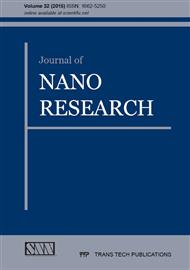[1]
P. Ghosh, G. Han, M. De, C.K. Kim and V. Rotello, Gold nanoparticles in delivery applications. Adv. Drug. Deliv. Rev. 60 (2008) 1307–15.
DOI: 10.1016/j.addr.2008.03.016
Google Scholar
[2]
G. Han, P. Ghosh, M. De and V. Rotello, Drug and Gene Delivery using Gold Nanoparticles. Nanobiotechnol. 3 (2007) 40-5.
DOI: 10.1007/s12030-007-0005-3
Google Scholar
[3]
D. A. Stead, Current methodologies for the analysis of aminoglycosides. J. Chromatogr. B. Biomed. Sci. Appl. 747(2000) 69–93.
Google Scholar
[4]
L. E. Bryan, S. K. Kowand and H. M. Van Den Elzen, Mechanism of aminoglycoside antibiotic resistance in anaerobic bacteria: Clostridium perfringens and Bacteroides fragilis. Antimicrob. Agents. Chemother. 15(1979) 7- 13.
DOI: 10.1128/aac.15.1.7
Google Scholar
[5]
T. P. Chaves, E. L. C. Clementino, D. C. Felismino, R. R. N. Alves, A. Vasconcellos, H. D. M. Coutinho et al. Antibiotic resistance modulation by natural products obtained from Nasutitermes corniger (Motschulsky, 1855) and its nest. Saudi. J. Bio. Sci. In press (2014).
DOI: 10.1016/j.sjbs.2014.12.005
Google Scholar
[6]
G. L. Burygin, B. N. Khlebtsov, A. N. Shantrokha, L. A. Dykman, V. A. Bogatyrev and N. G. Khlebtsov, On the enhanced antibacterial activity of antibiotics mixed with gold nanoparticles. Nanoscale. Res. Lett. 4(2009) 794–801.
DOI: 10.1007/s11671-009-9316-8
Google Scholar
[7]
B. Saha, J. Bhattacharya, A. Mukherjee, A. K. Ghosh, C. R. Santra, A. K. Dasgupta, and P. Karmakar, In Vitro Structural and Functional Evaluation of Gold Nanoparticles Conjugated Antibiotic. Nanoscale. Res. Lett. 2(2007) 614-622.
DOI: 10.1007/s11671-007-9104-2
Google Scholar
[8]
S. L. Best and P.J. Sadler, Gold Drugs: Mechanism of Action and Toxicity. Gold. Bull. 29(1996) 87-93.
DOI: 10.1007/bf03214741
Google Scholar
[9]
K. J. Klabunde and R.M. Richards, Nanoscale Materials in Chemistry. 2nd ed. Wiley; 2009.
Google Scholar
[10]
E.V. Shevchenko, D. V. Talapin, N. A. Kotov, S. O'Brien and C. B. Murray, Structural diversity in binary nanoparticle super lattices. Nature. 439(2006) 55-59.
DOI: 10.1038/nature04414
Google Scholar
[11]
B. Kumar, K. Smita, L. Cumbal and A. Debut, Synthesis of silver nanoparticles using Sacha inchi (Plukenetia volubilis L. ) leaf extracts. Saudi. J. Biol. Sci. 21(2014) 605–609.
DOI: 10.1016/j.sjbs.2014.07.004
Google Scholar
[12]
R. Vaidyanathan, K. Kalishwaralal, S. H. Gopalram and S. Gurunathan, Nanosilver-The burgeoning therapeutic molecule and its green synthesis. Biotechnol. Adv. 27(2009) 924–937.
DOI: 10.1016/j.biotechadv.2009.08.001
Google Scholar
[13]
B. Nair and T. Pradeep, Coalescence of Nanoclusters and Formation of Submicron Crystallites Assisted by Lactobacillus Strains. Cryst. Growth. Des. 2(2002) 293-298.
DOI: 10.1021/cg0255164
Google Scholar
[14]
T. J. Beveridge and R. G. Murray, Sites of metal deposition in the cell wall of Bacillus subtilis. J. Bacteriol. 141(1980) 876-887.
DOI: 10.1128/jb.141.2.876-887.1980
Google Scholar
[15]
G. Southam and T. J. Beveridge, The in vitro formation of placer gold by bacteria. Geochim. Cosmochim. Acta. 58(1994) 4527-4530.
DOI: 10.1016/0016-7037(94)90355-7
Google Scholar
[16]
S. Honary, E. Gharaei-Fathabad, Z. Khorshidi Paji and M. Eslamifar, A novel biological synthesis of gold nanoparticle by enterobacteriaceae family. Trop. J. Pharm. Res. 11(2012) 887-891.
DOI: 10.4314/tjpr.v11i6.3
Google Scholar
[17]
D. N. Correa-Llantén, S. A. Muñoz-Ibacache, M. E. Castro, P. A. Muñoz and J. M. Blamey, Gold nanoparticles synthesized by Geobacillus sp. strain ID17 a thermophilic bacterium isolated from Deception Island, Antarctica. Microb. Cell. Fact. 12(2013).
DOI: 10.1186/1475-2859-12-75
Google Scholar
[18]
A. K. Vala, Exploration on green synthesis of gold nanoparticles by a marine-derived fungus Aspergillus sydowii. Environ. Prog. Sustain. Energy. 34(2015) 194-197.
DOI: 10.1002/ep.11949
Google Scholar
[19]
D. Mandal, M. E. Bolander, D. Mukhopadhyay, G. Sarkar and P. Mukherjee, The use of microorganisms for the formation of metal nanoparticles and their application. Appl. Microbiol. Biotechnol. 69(2006) 485–492.
DOI: 10.1007/s00253-005-0179-3
Google Scholar
[20]
K. Lewis, A. A. Salyers, H. W. Taber, R. G. Wax, Bacterial resistance to antimicrobials. 1st ed. Marcel Dekker, INC. (2002).
Google Scholar
[21]
S. Yoshizawa, D. Fourmy and H. D. Puglisi, Structural origins of gentamicin antibiotic action. EMBO. J. 17(1998) 6437–6448.
DOI: 10.1093/emboj/17.22.6437
Google Scholar
[22]
A. Bryskier, Antimicrobial agents (antibacterial and antifungals). 3rd ed. ASM Press. (2005).
Google Scholar
[23]
L. Zhang, D. Pornpattananangkul, C. M. J. Hu and C. M. Huang, Development of Nanoparticles for Antimicrobial Drug Delivery. Curr. Med. Chem.; 17(2010) 585-594.
DOI: 10.2174/092986710790416290
Google Scholar
[24]
S. Khademi, H. Motamedi, A. Akbarzadeh Khiavi and M. R. Mehrabi, Gold nanoparticle biosynthesis by E. coli and conjugation with streptomycin and evaluation of its antibacterial effect. Curr. Nano. Sci. 10(2014) 553-561.
DOI: 10.2174/1573413709666131203231344
Google Scholar
[25]
J. M. Andrews, Determination of minimum inhibitory concentrations. J. Antimicrob. Therapy. 48(2001) 5- 16.
Google Scholar
[26]
M. Dworkin, S. Falkow, E. Rosenberg, K. H. Schleifer and E. Stackebrandt, The prokaryotes a handbook of the biology of bacteria. 3rd ed. Springer. (2006).
DOI: 10.1007/0-387-30746-x
Google Scholar
[27]
S. H. Sinha, L. Pan, P. Chanda and S. K. Sen, Nanoparticles fabrication using ambient biological resources. J. Appl. Biosci. 19(2009) 1113 –1130.
Google Scholar
[28]
P. Mohanpuria, N. K. Rana and S. K. Yada, Biosynthesis of nanoparticles: technological concepts and future applications. J. Nanopart. Res. 10(2008) 507–517.
DOI: 10.1007/s11051-007-9275-x
Google Scholar
[29]
V. K. Sharma, R. A. Yngard and Y. Lin, Silver nanoparticles: Green synthesis and their antimicrobial activities. Adv. Colloid. Interface. Sci. 145(2009) 83–96.
DOI: 10.1016/j.cis.2008.09.002
Google Scholar
[30]
K. Prasad, A. K. Jha and A. R. Kulkarni, Lactobacillus assisted synthesis of titanium nanoparticles. Nanoscale. Res. Lett. 2(2007) 248–250.
DOI: 10.1007/s11671-007-9060-x
Google Scholar
[31]
S. Minaeian, A. R. Shahverdi, A. S. Nohi and H. R. Shahverdi, Extracellular biosynthesis of silver nanoparticles by some bacteria. J. Sci. I. A. U. (JSIAU) 17(2008)1-4.
Google Scholar
[32]
J. Xie, J. Y. Lee, D. I. Wang and Y. P. Ting, Identification of active biomolecules in the high-yield synthesis of single-crystalline gold nanoplates in algal solutions. Small; 3(2007) 672-682.
DOI: 10.1002/smll.200600612
Google Scholar
[33]
S. K. Das and E. Marsili, A green chemical approach for the synthesis of gold nanoparticles: characterization and mechanistic aspect. Rev. Environ. Sci. Biotechnol.; 9(2010) 199-204.
DOI: 10.1007/s11157-010-9188-5
Google Scholar
[34]
M. E. Levison, J. L. Bran and K. Ries, Treatment of Anaerobic Bacterial Infections with Clindamycin-2-Phosphate. Antimicrob. Agents. Chemother. 5(1974) 276-280.
DOI: 10.1128/aac.5.3.276
Google Scholar


